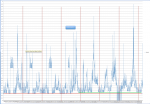- Mar 22, 2013
- 11
I just replaced my old WhisperFlo .5 HP pump with an Intelliflo VF (011012). First things first, the difference in power efficiency and sound is mind-blowing. Granted, my WhisperFlo is on its last legs, but the VF moves the same amount of water [edit:] for much less power. And, I can hardly tell its on. Very impressed.
However, as I have recently been on a power efficiency kick, I have noticed that the IntelliFlo seems to use somewhere in the neighborhood of 20-30 Watts in standby as measured by my whole house energy monitor. That is to say, I am inferring this change based on the higher baseline power usage at night when basically everything is off. I am not sure of a good way to test the pump directly since it is hardwired, but I may experiment with flipping the subpanel breaker to cut power from it. My hope is that will not erase all of its settings.
In any event, has anyone tested these pumps' standby power usage and/or noticed an unusually high standby power draw? I have attached a graph showing power usage and approximate baseline differences before and after the pump. You can also see the massive difference in power usage (despite running the pump for 2 hours more per day.
However, as I have recently been on a power efficiency kick, I have noticed that the IntelliFlo seems to use somewhere in the neighborhood of 20-30 Watts in standby as measured by my whole house energy monitor. That is to say, I am inferring this change based on the higher baseline power usage at night when basically everything is off. I am not sure of a good way to test the pump directly since it is hardwired, but I may experiment with flipping the subpanel breaker to cut power from it. My hope is that will not erase all of its settings.
In any event, has anyone tested these pumps' standby power usage and/or noticed an unusually high standby power draw? I have attached a graph showing power usage and approximate baseline differences before and after the pump. You can also see the massive difference in power usage (despite running the pump for 2 hours more per day.



